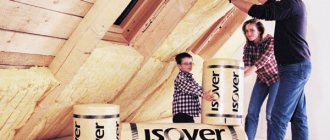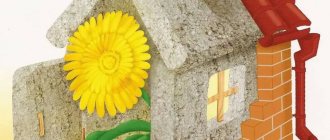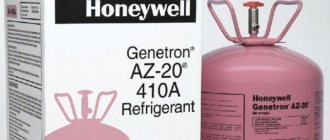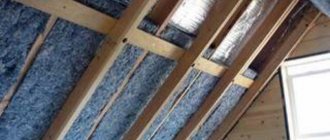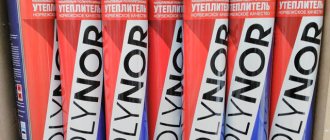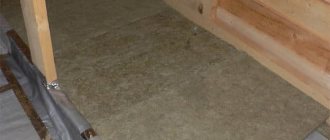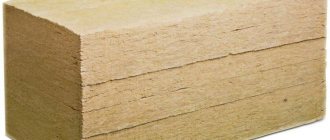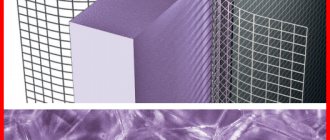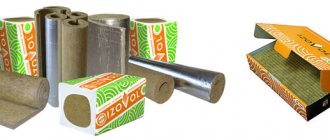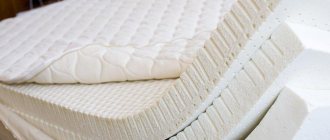If you are planning to build a house for yourself and are choosing insulation, then this article is especially for you. In this article we will introduce you to the insulation material - Ecowool.
In the photo there is a 15kg Ecowool briquette (Donskaya Ecowool, Tula)
In the photo there is a 15kg Ecowool briquette (Donskaya Ecowool, Tula)
Table of contents:
- A little history
- Ecowool composition
- What is Borax
- Boric acid
- Ecowool insulation cost
- Thermal conductivity Ecowool
- Air permeability Ecowool
- Energy efficiency Ecowool
- Capillary activity of Ecowool
- Fire safety Ecowool
- Environmental friendliness Ecowool
- Rodents and mice in Ecowool
- Ecowool - antiseptic
- Noise insulation Ecowool
- Heat capacity of ecowool
- Ecowool shrinkage
The history of ecowool
Ecowool is the Russian name for cellulose insulation. In world practice it is called “Cellulose Insulation”. Ecowool appeared in Russia in 1993, but in world practice it became known already at the beginning of the last century. In 1928, the first production of this insulation was created in Germany. Today, this insulation is well known and popular in many countries around the world. This insulation is especially popular in countries located in northern latitudes, in the humid climate zone:
- Finland
- Sweden
- Norway
- Germany
- Canada
- USA and other countries
According to the Russian information portal Wikipedia, in Finland, cellulose insulation accounts for up to 70% of the total market for insulation used in individual housing construction.
Types of equipment for do-it-yourself penoizol basic equipment
The production of insulation can be established in any room, but it is recommended to do this directly at the work site in order to save on transportation.
To make the unit you will need:
- Foam pump.
- Foam generator.
- Solution pump.
- Electricity.
- Compressor.
Equipment for the production of insulation today on the construction market is presented from different manufacturers. The models differ in their characteristics and cost. The average price of the device is 35,000 rubles. Experts recommend giving preference to installations that are manufactured in Russia or Ukraine.
What does this insulation consist of?
Ecowool 81 % recycled cellulose (newsprint paper), 7 % of Borax anti-friction agents (flame protection) and 12 % of natural antiseptics Boric acid (protection from rodents, mold, insects)
Ecowool composition
This is what ecowool looks like up close, it is a fibrous crushed material, gray in color, some inclusions may be present in the form of scraps of newspaper waste paper, sometimes you can even make out the text.
Fiber structure Ecowool
It has no smell and does not generate dust. Ecowool can be compressed, it takes a fixed shape, this can be used, for example, when installing this insulation into small cracks yourself. In addition, there is no need to fear that it will fall out of the holes through which it was mounted. It holds its shape and will not fall out anywhere.
Industrial production and crazy hands
It’s worth clarifying right away: the idea of using paper for insulation is not new. Ecowool, one of the fairly popular insulation materials, consists almost entirely of cellulose and is made from recycled waste paper. We will devote a separate article to its properties.
However, along with the industrial production of ecowool, insulation with cardboard and paper is also practiced without their additional processing; As an option, insulation boards are made independently. We will also pay attention to this use of cellulose.
Same composition in all countries
I would like to especially draw your attention to the fact that despite the wide geography of application of this insulation, in almost all countries, including Russia, the manufacturing technology of this material, its composition, are almost the same - it includes three components: this is cellulose - newspaper waste paper, this is borax and boric acid .
If everything about waste paper is very clear, then about borax and boric acid, not so much. Let's look at them in more detail:
Conclusion
Using kraft paper as insulation has both positive and negative sides. The undoubted advantages of this insulation are the low cost of the material and the ability to perform insulation quickly and easily. In addition, given the growing attention to the problem of environmental safety, choosing kraft paper is the best option in terms of ecology: such insulation does not emit harmful substances.
The topic of our article is paper insulation. No, do not rush to cover the walls of your house with old “Roman newspapers”: paper in its pure form is too afraid of moisture, and its density is too high for an insulating material.
However, it is still possible to use cellulose for thermal insulation.
Let's hope that more civilized methods of insulation will be found.
So, what is Borax?
Sodium tetraborate (“borax”, “borax” (from Latin borax
)) is an inorganic compound, sodium salt of boric acid with the chemical formula Na2B4O7, the most common and used boron compound, forms several crystalline hydrates, and is widely used in industry.
In the photo "Bura"
Sodium tetraborate (Borax) is used:
- as a raw material for the production of boric acid and various boron compounds
- in the production of enamels, glazes, optical and colored glasses, various ceramics
- when soldering and melting metals in flux
- in the paper and pharmaceutical industries
- in the production of building materials as an antiseptic component for the production of cellulose insulation ecowool
- as a disinfectant and preservative
- for preparing buffer solutions
- in analytical chemistry (as a standard substance for determining the concentration of acid solutions)
- for qualitative determination of metal oxides (by pearl color)
- in photography - in slow-acting developers as a weak accelerating agent
- as a component of detergents
- as a component of cosmetics
Boric acid
Boric acid (orthoboric acid or lat. acidum Boricum) is a weak, monobasic Lewis acid, often used as an insecticide, antiseptic, and fire retardant.
In the photo "Boric acid"
Application
- Boron fertilizer
- Used in laboratories to prepare buffer solutions
- In medicine - as an independent disinfectant for adults, and also in the form of a 2% solution - for washing the skin after contact with alkalis
- Also, various combination preparations are produced based on boric acid (ATX group D08AD), for example Teymurov’s paste
- Registered in the food industry as food additive E284
- In jewelry - as the basis of fluxes for soldering gold-containing alloys
- In everyday life - extermination of cockroaches, ants, bedbugs
- In the production of ceramics, fiber optics, fiberglass, glass
- As a fire retardant to protect wood
- As part of electrolytes for copper and nickel plating
Cost of insulation - Ecowool
For correct calculation, let's take the insulation thickness of 100 mm. The price will include all work and the material itself.
Horizontal surface - 190 R/m2
Sloping and vertical surfaces from 240 R to 350 R/m2
The approximate cost of insulating a house with a total area of 120-150 m2 on a turnkey basis (thermal circuit) ranges from 100 to 200 thousand rubles. The price is comparable to all types of insulation with basalt or mineral slabs.
Insulation calculator
Ecowool calculation calculator
Thermal conductivity Ecowool
Thermal conductivity is the ability of material bodies to conduct energy (heat) from more heated parts of the body to less heated parts of the body through the chaotic movement of body particles (atoms, molecules, electrons, etc.).
The thermal conductivity coefficient of ecowool is 0.039 (W/m*K)
For understanding, below are data on the most common types of insulation.
Thermal conductivity table
The table shows that the thermal conductivity coefficient of ecowool is higher than the average result.
Air permeability of ecowool
Thanks to the technology of seamless application and the dense fibrous structure of the material, ecowool has low air permeability. The absence of joints and cracks determines the future tightness of the entire building.
A house insulated with cellulose fiber is 40% more energy efficient
There is a video on the Internet devoted to a comparative analysis of this “tightness” parameter. In America, they took two houses, identical in design, one house was insulated with mineral wool, the second house was insulated with cellulose insulation. And when we compared the tightness of the thermal insulation circuit of these 2 buildings, we were surprised to find that the tightness of a house insulated with cellulose insulation was 40 percent higher than the figure for a house insulated with traditional fiberglass. Here is the link to this video.
Mechanical laying
This method requires the use of pneumatic blowing installations. The material is loaded into the installation, where it is loosened. Then the cotton wool is delivered to the desired location by air flow. An important advantage of the method is that mechanical pneumatic laying forms a thermal insulation contour without seams or joints. It allows the insulation to penetrate into places that are inaccessible with other installation options or the use of other insulation materials: crevices, cracks, potholes, chips, grooves and cavities.
This method is applicable in an occupied house and when performing repair work.
Positive properties of corrugated cardboard as insulation:
High capillary activity of ecowool
Ecowool has high capillary activity
What it is? What does this give?
There are 2 mechanisms of moisture transfer inside the insulation:
- Capillary
- Diffusion
Thanks to wood fiber, ecowool uses both of these mechanisms; mineral types of insulation have only one - diffusion . Ecowool mainly consists of cellulosic wood fiber. When moistened, the fiber is able to absorb moisture and distribute it throughout the entire volume of the insulation. Due to the different molecular structure, basalt insulation cannot distribute moisture.
The photo shows the structure of the molecules of ecowool and mineral wool
This is a rather complex phenomenon and it gives rise to great controversy regarding the use of vapor barrier when insulating with ecowool. Proponents of the idea that a vapor barrier is not needed precisely mean this additional mechanism of moisture transfer, which works in the opposite direction and ecowool has the ability to dry not only outside, but also inside.
Capillary activity provides a number of advantages to ecowool,
compared to insulation materials that do not have
capillary activity.
No processing
Kraft paper
Let's start by getting to know one fairly popular type of cellulose product.
Kraft paper is a very durable material that is made from long fibers of kraft pulp. Raw materials - wood; wood chips are boiled in an aqueous solution of sodium sulfide and some other substances.
It’s interesting: the process is extremely technological, since it allows the use of wood of any species. In addition, the chemicals used are recovered and can be reused. Yeast, soap, turpentine, rosin, methyl alcohol and many other useful products are obtained from by-products.
Everyone is familiar with kraft paper in this capacity.
How is thin and thick kraft paper useful in terms of insulation?
Of course, not as a thermal insulation material.
- The classic design of a frame house is a frame made of timber, sheathed inside and outside with clapboard, OSB or plywood . The space between the outer and inner skins is filled with insulation. It is often used mineral wool, polystyrene foam and other modern materials for insulation; The heat-insulating material is protected from blowing and moisture saturation by special polymer films. This scheme has two disadvantages:
- The materials used are of artificial origin and often continue to saturate the air in the house for many years with phenolic resins, styrene or fine mineral fibers that irritate the eyes and respiratory organs.
- They are by no means cheap.
Pros of high capillary activity
- When moistened, the insulating properties of the insulation are preserved.
- Due to the redistribution of moisture through the capillaries, there are no zones of local waterlogging.
This is important when there is some kind of defect in the vapor barrier.
3. Condensation does not form in Ecowool.
4. Ecowool, due to the capillary mechanism, can affect the humidity of the room air. It absorbs excess moisture and releases it when the room becomes dry, that is, like wood fiber, it is a passive regulator of air humidity in the room.
If you do not plan to install supply and exhaust ventilation, then this property will significantly add comfort to your home.
Eco-friendliness of ecowool
There is a lot of controversy about the environmental friendliness of ecowool. There are extreme supporters that it is very environmentally friendly. Others say that it is not at all environmentally friendly, let's try to figure it out.
Ecowool consists of three components:
- Newspaper waste paper
- Borax
- Boric acid
“Ecowool is full of lead because it’s made from newsprint.”
As for newspaper waste paper, it means there is no lead in the newspaper since it has long been produced in a way that eliminates the presence of lead in the equipment.
“Printing ink is harmful to health”
The harm caused by printing ink is greatly exaggerated; it has its own hygienic certificate, on the basis of which newspapers are produced. Millions of people read, touch, enclose every day and no one has yet gotten sick, much less died, from contact with printing ink. So we can say with confidence - “This is a myth”
Borax and boric acid in ecowool
Borax and boric acid are non-volatile natural chemical components. The scope of application of these two materials is completely different, and now discussing the harm of borax and boric acid on human health will take a lot of time.
Borax and boric acid are non-toxic and non-volatile compounds, they are quickly eliminated from the human body, but perhaps the most decisive argument in favor of not exaggerating the harm of the presence of this chemical in ecowool is the fact that all countries in Europe and America use this technology and the recipe for making this material.
In these countries, hygiene requirements are more stringent, and despite this, ecowool is widely used in this particular composition. In addition, ecowool contains no phenols, formaldehydes, or any carcinogenic binders. Ecowool does not contain microscopic allergenic dust, which is present in many types of insulation.
Ecowool antiseptics wood
The presence of borates contributes to the preservation of wood in contact with Ecowool and prevents the growth of bacteria.
An example of roof insulation with mineral wool
Borax and boric acid are highly toxic to certain types of microorganisms, in particular most types of mold and mildew, so mold stops upon contact with this chemical compound and does not spread further
“Why are borates used and not some other chemical compounds?”
In Germany in 1985 The Institute of Construction Technologies recognized that borates are one of the most effective means of protecting wood from mold and mildew, which is why borates are present in ecowool.
We use foam plastic
Polystyrene foam is a universal insulation material. It is suitable for both internal and external insulation of a house. It is also used everywhere to insulate frame walls. If you don’t know which polystyrene foam you should choose, pay attention to the operating features of polystyrene foam slabs. Read more about foam insulation here.
Insulation of a frame house with foam plastic
If you need to insulate the base (foundation), then choose a material marked “for foundation”. If you need to insulate the floor, pay attention to the increased density - such sheets do not deform under heavy loads. Less dense foam plastic is suitable for insulating a wall or roof, since there is almost no load in these places, and a lower density improves thermal insulation.
What thickness of insulation should I choose for the optimal wall thickness? The thickness of the insulation should be equal to the thickness of the timber in the frame. Usually this is 15 cm. If you don’t know what to choose - a sheet of foam plastic 15 cm or two sheets of 10 cm and 5 cm, then it is better to use sheets of the second option. A small air gap, which will still be between the two slabs, will make the frame house warmer.
Installation of an insulated frame
We fix the foam with glue, and between the sheets it is secured with fungi - special “nails” with very wide heads. They additionally hold the foam.
Ecowool has a high degree of noise absorption
Ecowool is a very good noise-absorbing material in terms of absorbing high and medium frequencies. It works no worse than basalt or fiberglass.
An example of soundproofing a room with Ecowool. Installation was carried out by Ekovata-MSK
When absorbing noise, one must take into account the fact that ecowool is a seamless technology, and in acoustics, as in heating engineering, there are requirements for the tightness of the circuit - any gap or leak is a so-called sound bridge, which significantly impairs the sound insulating ability of the enclosing structure.
How to insulate a frame house for winter living?
In order to live comfortably in a frame structure and in winter, the material used for insulation must have the following qualities:
- Environmental friendliness - insulation should not contain substances that can cause harm to health.
- Fire resistance - the material should not ignite, and in the event of a fire, emit a large amount of smoke.
- A small thermal conductivity coefficient is optimal if the winter insulation in a frame house is within 100-150 mm.
- Strength and tightness - the insulation must tightly fill the gaps of the frame.
- Easy installation of thermal insulation.
To insulate a frame house, it is customary to choose between polystyrene foam, extruded polystyrene foam, mineral wool, basalt wool and polyurethane foam.
Let's look at the advantages and disadvantages of each.
Styrofoam
The material is considered the warmest, but is less suitable than others for insulating frame houses. Features of use:
- Polystyrene foam is rigid slabs, they are laid on a flat wall. For a frame house, this insulation option is only suitable if the surface is perfectly flat, otherwise cold air will leak through the gaps.
- The material should not be placed near fire sources.
- It does not allow moisture to pass through and requires the installation of reliable waterproofing and vapor barriers.
- light weight, which makes the installation process simple;
- does not lose its properties due to temperature changes.
Extruded polystyrene foam
This is a high-quality material with good thermal insulation properties. Made from granulated polystyrene and foaming agent.
- Low water absorption. This indicator remains unchanged even at high humidity.
- No additional waterproofing required.
- Strength.
- Low flammability.
- Can be used at temperatures from -50 to +75 degrees.
- Environmentally friendly and harmless to health.
- You can install it yourself.
- Low vapor barrier. To improve the indicator, installation of ventilation is required.
- High price.
- Installation of an additional frame on which the material will be attached.
- Application of a special composition to polystyrene foam to protect against UV rays.
The heat capacity coefficient of ecowool is 3 times higher than any insulation
Ecowool has a high heat capacity . Its heat capacity coefficient is three times higher than that of mineral insulation. This may be useful for you if, say, for some reason the heat source turns off and your house will cool down more slowly than if it is insulated with mineral wool.
Well, or on a hot sunny summer day on the second floor under an attic roof, insulated with ecowool, it will be a little more comfortable than if there was mineral wool.
Example of roof insulation with Ecowool
Laying mineral wool
If you decide to insulate walls and other parts of a frame house and choose mineral wool, remember that the most important thing is to protect it well from moisture. Insulating a house without waterproofing does not make any sense, since the abundance of moisture makes the fibers heavier, it crumples, sticks together, the volume of wool decreases, free spaces appear, and the house is blown through.
Mineral wool is sold in the form of mats and in rolls. When stacking rolls, it is advisable to have a helper to help hold the roll on top while you unwind it down.
If you do not have an assistant and you doubt that you will be able to lay the rolled cotton wool evenly, it is better to opt for mats. The mats are stacked on top of each other from bottom to top and securely fixed between the frame beams. The most important thing is that they must fit tightly to each other. The waterproofing film, which is nailed to the studs using bars, also helps the mineral wool maintain its position. Read more about mineral wool insulation here.
Insulation with mineral wool and fixation with fungi
Ecowool shrinkage
The most common and popular question when the choice falls on this type of insulation. Let's take a closer look here.
To begin with, let's divide the structural elements of the house into 3 groups :
- Horizontal (Floor, attic, ceiling)
- Inclined (Roof, attic)
- Vertical (Walls)
Let's highlight 2 main methods of applying ecowool
- Dry blowing
- Wet glue method
Horizontal surfaces
In this case, the floors are insulated with ecowool. With the help of a regular backfill, it is called “free backfill”, even when ecowool is simply poured onto a hemmed base with a certain layer of insulation and a heat-insulating layer is obtained. Here the density of Ecowool will be about 35 kg/m3.
Insulation of a 200mm floor using the dry backfill method.
With this method of insulation, shrinkage will be about 7-10%. Accordingly, the actual insulation thickness will be approximately 180mm .
Cannot be applied using wet glue method
Sloping surfaces (attics, roof slopes)
It is insulated using the “dry blowing” method. For high-quality non-shrink insulation of the roof with ecowool, it is necessary to properly prepare the base. Let us highlight the main stages of preparation:
- Under an insulated roof, it is necessary to use a vapor-permeable diffusion membrane to allow excess moisture to escape into the ventilation gap. The membrane should be well tensioned, without sagging or damage. Cut-offs must be installed along the lower perimeter of the roof.
Example of a roof before insulation
2. An internal diffusion membrane or vapor barrier is stretched along the straps. To create a rigid internal base and achieve an ecowool density of 50 kg/m3, it is necessary to attach a special retaining plastic mesh over the membrane. and the photo is a prepared roof without insulation
The photo shows a prepared roof without insulation
3. Fill the prepared base with ecowool using dry blowing. There is no need to close the holes in the mesh and membrane.
The process of installing Ecowool insulation on the roof
With this method of installation and preparation of the roof, ecowool is guaranteed not to sag even after a large number of years.
The wet-glue method is not applicable for roof insulation
Vertical surfaces (Walls)
Walls are insulated in two ways:
- Dry blowing method
- By wet-adhesive spraying method
Let's look at each of them separately.
Method of dry blowing into walls
For this method it is necessary to create a rigid base, both from the outside and from the inside. It is necessary to ensure the presence of horizontal cutoffs along the perimeter of all walls at a height of approximately 1.5 meters from the floor.
Horizontal cut-off at 1.5 meters from the floor
Next, sew up the walls with any slab material:
- CSP (cement particle board)
- OSB (Oriented Strand Board)
- Beltermo (Insulating fibreboards)
On the other side, sew up with a membrane and a special retaining mesh
The photo shows an example of a wall sewn from the inside
Next, ecowool is blown into the prepared base under a pressure of 65 kg/m3 . With this method of application and preparation of walls, shrinkage of ecowool is guaranteed not to occur.
Wet glue method
With this method of applying ecowool, there is no need to make additional cuts and install a rigid base of the walls on both sides. It is enough to stretch special holding threads inside the walls; they will protect the ecowool from subsequent shrinkage.
Application of ecowool using the wet-glue method
Ecowool consumption with this method is 30-40% higher than with dry blowing. After ecowool has dried, the density will be approximately 55 kg/m3 .
In custody:
Today in Russia there are dozens of enterprises that produce Ecowool, but there is still no GOST or a single standard that would strictly regulate the quality of the material and the technological process. Manufactures operate on the basis of technical specifications that they write for themselves, so the quality can vary greatly.
2 types of Ecowool enterprises in Russia:
the first group is the one that works on a high-performance automated expensive imported production line, for example, Finnish, which specializes in the manufacture of equipment for the production of Ecowool.
The second group of productions are those productions that operate on budget lines of domestic production. In this production chain, as a rule, there may not be automation, no Baratov additives, no dust collection systems, and not a sufficient number of steps for crushing waste newspaper into the required fiber.
Self-production of cellulose boards
Is it possible to make more convenient paper insulation with your own hands?
Yes, you can make some kind of thin and dense insulation from waste paper. Whether the result is worth your time is debatable; however it is possible.
Here is a description of the production process.
- The paper is shredded and poured into a barrel. The smaller the fragments, the better the result. Then it is soaked for a day or two. Water should completely fill the paper.
- After this time, water is added to the barrel at the rate of 20 liters per kilogram of waste paper.
- An oil emulsion is made in a separate container: 100 grams of machine oil and water are taken per 200-liter barrel. The mixture is whipped with a mixer and added to the barrel: it will make the material hydrophobic.
- Add 100 grams of soda ash to the barrel (it will reduce the ability of the insulation to ignite) and 20 grams of boric acid (an antiseptic).
- Beat the mixture thoroughly. This can be done with an improvised mixer: three pieces of 4 mm wire are clamped into the drill chuck; then the last 15 centimeters of each segment are bent radially.
- After 5-7 days of settling, the mixture is whipped again. It should become as homogeneous as possible: in this case, the density of the insulation will be minimal, and the yield of useful volume will be maximum.
- We are constructing a mold for the future insulation board. Overall dimensions are arbitrary (you can focus on 50x100 centimeters). The bottom is a mesh on a solid base that allows water to pass through, or simply polyethylene pierced in several places with an awl and laid out on flat sand.
